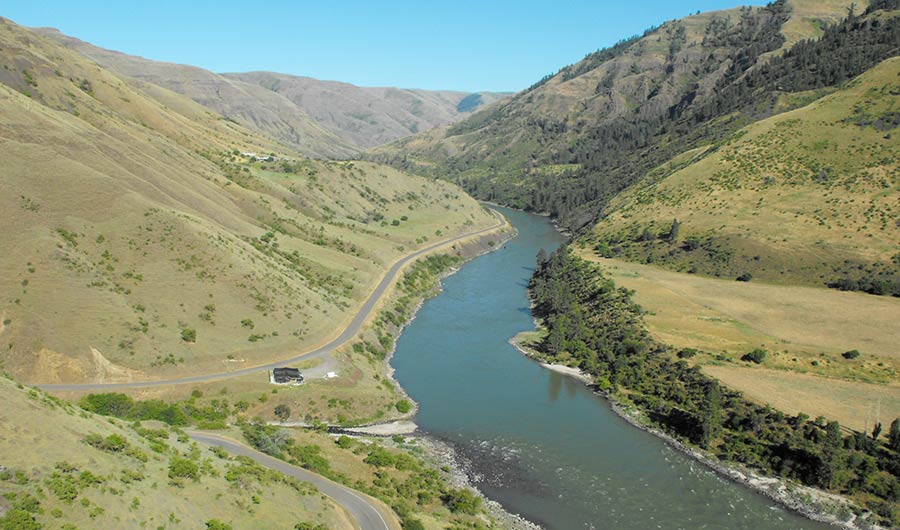Mounting Evidence Suggests People First Came to North America by Boat

The Cooper's Ferry area, Idaho.
Image credits: Loren Davis, Oregon State University
(Inside Science) -- Ancient stone artifacts and other traces of human activity may be the oldest evidence yet of people living in the Americas, potentially supporting the increasingly popular notion that the first migrants to the New World came along its coasts rather than over a land bridge, a new study finds.
When and how the Americas were first settled remains hotly debated. The longstanding prevailing theory was that migrants initially entered the New World from Beringia, the landmass that once connected Asia and North America and is now mostly submerged under the icy waters of the Bering Strait. Receding glaciers may have opened up a passage running southward from Beringia to the Americas as early as 14,800 years ago, although it was unlikely to have been traversed immediately.
However, a small but growing body of research has suggested people were present in the Americas centuries before this ice-free corridor existed, with some radiocarbon dates hinting at sites up to nearly 15,000 years old and other less reliably dated sites going back 16,000 years, said study lead author Loren Davis, an archaeologist at Oregon State University in Corvallis. This has led some researchers to suggest the earliest migrants came in boats along the Pacific coast, living off fish, kelp and other marine resources.
In the new study, Davis and his colleagues investigated Cooper's Ferry, an archaeological site located in the lower Salmon River canyon in western Idaho. Excavations can prove challenging -- "summer temperatures are hot, up to 120 degrees Fahrenheit, and we have to bring water from afar to our camp each week," Davis said. Moreover, "we are always on the lookout for rattlesnakes and black widow spiders."
Over the past two summers, the scientists reached the site's bottom layers, which they expected to contain its earliest artifacts. They radiocarbon dated animal bone fragments from this layer and found that humans may have occupied the site as early as roughly 16,560 years ago.
"This may be among the earliest evidence of occupation of the Americas yet," Davis said. "If one had to explain why there were people in Idaho before continental ice sheets had a breach in them through which one could walk north to south, the most parsimonious explanation might be they came down the coast. It may be no coincidence that if one moved down along the Pacific Coast and then went down the Columbia River into the interior of North America, after a while, if they made a lefthand turn, it would not take too long to get to the Cooper's Ferry site."
Paleoanthropologist John Hoffecker at the University of Colorado at Boulder, who did not take part in this research, felt the earliest suggested dates for this site may prove to be statistical anomalies. Still, even if artifacts at the site only ranged as old as 14,500 years old, which Hoffecker felt was more supported, "that still is great support for the coastal route migration hypothesis," he said. Hoffecker noted that while multiple studies have suggested that an ice-free corridor providing overland access southward from Beringia began to open up about 14,800 years ago, it likely wasn't a viable route for humans until after 13,000 years ago. This means that the early Native Americans who occupied Cooper's Ferry must have traveled from Beringia to areas such as the Columbia River via the Pacific coast.
The earliest artifacts unearthed at Cooper's Ferry are stone projectile heads with stems that differ significantly from those of the Clovis prehistoric culture once thought the first inhabitants of the Americas. Clovis stone points have distinct fluted channels at their bases that the Cooper's Ferry points lack. According to Davis and his colleagues, the points they found closely resembled artifacts from northeastern Asia, particularly Japan. They are now collaborating with Japanese researchers to conduct further comparisons of artifacts from Japan, Russia and Cooper's Ferry.
However, previous analyses of genes and teeth "do not support an origin for Native Americans out of northern Japan, beyond any reasonable doubt," Hoffecker said. Archaeologist Ben Potter at the University of Alaska at Fairbanks, who did not participate in this study, suggested the similarities between the Cooper's Ferry and ancient Japanese artifacts were superficial, and that microblades and other artifacts typically seen at ancient Japanese sites were not found at Cooper's Ferry or elsewhere in North America.
Still, although Native Americans might not descend from Japanese people, it might be possible the prehistoric denizens of Cooper's Ferry and ancient Japan may have derived the knowledge to make their stone points from a common source that perhaps lived in Beringia, Hoffecker suggested. On the other hand, "the similarities may just be a case of convergent evolution," he added.
Davis and his colleagues detailed their findings in the Aug. 30 issue of the journal Science.
Editor's note (September 3, 2019): This story has been edited to clarify the descriptions of when glaciers in North America receeded, allowing people to travel along land.

